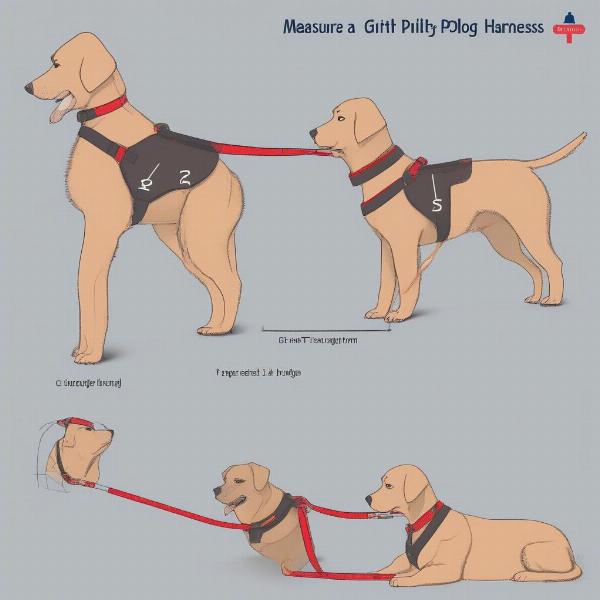A dog pulling harness can transform your walks from a struggle to a shared adventure, especially if you have a strong, energetic dog. But with so many options available, selecting the right harness can be overwhelming. This article will guide you through everything you need to know about dog pulling harnesses, from understanding the different types to choosing the perfect fit for your furry friend. Let’s dive in and discover how to make walks enjoyable for both you and your dog.
Understanding the Different Types of Dog Pulling Harnesses
There are three main types of dog pulling harnesses: X-back, H-back, and Y-front. Each design offers unique benefits and is suited for different activities and dog breeds.
X-Back Harnesses
X-back harnesses, as the name suggests, feature straps that cross over the dog’s back, forming an “X” shape. This design allows for a wide range of motion and is generally suitable for dogs who pull moderately.
H-Back Harnesses
H-back harnesses have a horizontal strap across the dog’s back, connecting to the front chest strap. This design is often preferred for dogs who pull heavily, as it distributes pressure evenly across the chest and back.
Y-Front Harnesses
Y-front harnesses have a strap that forms a “Y” shape on the dog’s chest. This design is known for its comfort and is a good choice for dogs with sensitive skin or those prone to chafing.
 How to Properly Fit a Dog Pulling Harness
How to Properly Fit a Dog Pulling Harness
Finding the Perfect Fit for Your Dog
Ensuring a proper fit is crucial for your dog’s comfort and safety. A harness that is too tight can restrict breathing and movement, while a harness that is too loose can slip off or cause chafing.
- Measure your dog: Use a flexible measuring tape to determine your dog’s girth (around the widest part of the chest), neck circumference, and length (from the base of the neck to the base of the tail).
- Consult the size chart: Refer to the manufacturer’s size chart and choose the appropriate size based on your dog’s measurements.
- Check the fit: Once the harness is on, ensure that you can fit two fingers comfortably between the harness and your dog’s body. The harness should be snug but not restrictive.
Benefits of Using a Dog Pulling Harness
Using a dog pulling harness offers several advantages over traditional collars, especially for dogs who tend to pull on the leash.
- Reduced strain on the neck: Harnesses distribute pressure across the chest and back, minimizing strain on the delicate neck area.
- Better control: A harness provides better control over your dog, especially in situations where they may be tempted to pull.
- Increased comfort: A well-fitted harness is generally more comfortable for dogs than a collar, particularly during activities like pulling or running.
Choosing the Right Harness for Different Activities
The type of pulling harness you choose should depend on the activity you plan to do with your dog.
- Canicross: For canicross, an X-back or H-back harness is generally recommended.
- Bikejoring: H-back harnesses are often preferred for bikejoring due to their stability and control.
- Sledding: For sledding, an H-back harness is typically the best choice.
“A properly fitted harness is essential for both the dog’s comfort and the handler’s control,” says Dr. Emily Carter, a certified veterinary behaviorist. “It’s crucial to select a harness that distributes pressure evenly and allows for a full range of motion.”
“Remember to introduce the harness gradually and associate it with positive experiences,” adds certified dog trainer, Mark Johnson. “This will help your dog feel comfortable and confident wearing the harness.”
Conclusion
Choosing the right dog pulling harness is a crucial step in ensuring enjoyable and safe walks for both you and your furry friend. By understanding the different types of harnesses, finding the perfect fit, and considering the intended activity, you can make an informed decision that will enhance your shared adventures. Start exploring the world of dog pulling harnesses today and discover the difference it can make!
FAQ
- What is the best type of harness for a dog that pulls a lot? H-back harnesses are generally recommended for strong pullers.
- How do I know if my dog’s harness fits correctly? You should be able to fit two fingers comfortably between the harness and your dog’s body.
- Can I use a regular harness for pulling activities? While some regular harnesses can be used for light pulling, it’s generally recommended to use a dedicated pulling harness for activities like canicross or bikejoring.
- Are there any breeds that shouldn’t use a pulling harness? Brachycephalic breeds (those with short noses) may require special consideration, and it’s always best to consult with your veterinarian.
- How do I introduce my dog to a pulling harness? Introduce the harness gradually and associate it with positive experiences, like treats and praise.
- Can puppies wear pulling harnesses? Yes, but it’s important to choose a harness specifically designed for puppies and ensure a proper fit.
- How often should I clean my dog’s pulling harness? Clean the harness regularly, following the manufacturer’s instructions.
ILM Dog is your one-stop resource for expert advice on all aspects of dog care, from breed selection to senior care. We cover a wide range of topics, including health and medical care, training and behavior, nutrition, grooming, exercise, puppy care, senior dog care, travel with dogs, and product reviews. For personalized advice or to learn more about our services, please contact us at [email protected] or call us at +44 20-3965-8624. Visit ILM Dog for more helpful information and resources.